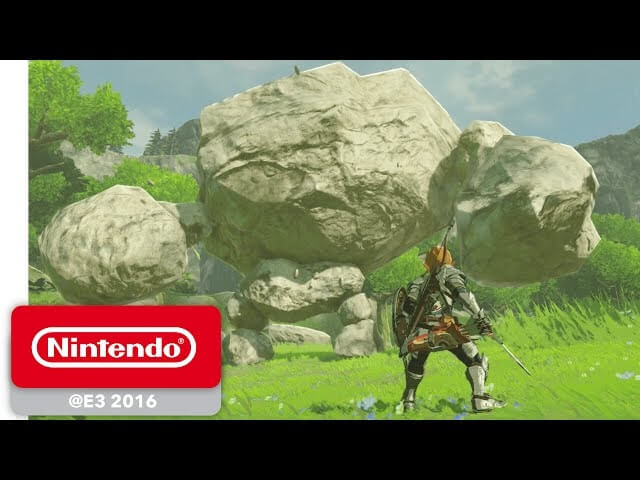The most promising games from E3 2016, part two

E3 2016 is all said and done, but as promised, I’ve still got a few exciting games to tell you about. You can find part one of my cream-of-the-crop roundup—which includes my impressions of God Of War, Titanfall 2, Horizon: Zero Dawn, and more—right here. And to get a taste of the E3 games that had the Gameological community buzzing, take a look at last week’s What Are You Playing This Weekend? comment thread.
The Legend Of Zelda: Breath Of The Wild
Developer: Nintendo
Publisher: Nintendo
Platforms: Wii U, whatever the NX ends up being called
Release date: 2017
Between God Of War, the shrinking show floor, and The Legend Of Zelda: Breath Of The Wild, it’s safe to proclaim “change” as one of the biggest themes of E3 2016. Breath Of The Wild is a shockingly different Zelda game. It takes just as many cues from Far Cry 3 and Skyrim as Ocarina Of Time. I didn’t get to spend much time in the small slice of the game’s humongous open world that Nintendo was showing off, but my half-hour demo revealed a game that was both dizzyingly complex and effortlessly approachable in that distinct Nintendo way.
The game’s controls are the most intimidating thing about it. They’ve been completely reconceived to fit with this new style of game, and the odd layout and endless combinations take a lot of getting used to. For example, you can surf down the side of a hill on your shield, but pulling that off requires getting into position, holding the shield button, jumping, and then immediately pressing another button in midair to stick the board under your feet. In battle and with his shield readied, Link can still jump away from opponents to dodge their strikes, but now that ability is mapped to a dedicated jump button. If you’d rather tempt fate, you can press another button to swing Link’s shield and parry the enemy attack, Dark Souls style. With the way you play Zelda not having changed in nearly 20 years, all these tweaks and complications require some serious readjustment that I wasn’t quite able to accomplish in my time with the game.
I might have been stumbling around this world, but it was a dazzling experience nonetheless. Much like Horizon: Zero Dawn, Breath Of The Wild’s Hyrule is a land reclaimed by nature. What’s left of the past society, one that seems far more technologically advanced than what we’ve seen in past Zeldas, lies in ruins or peeks out from under the earth. These tantalizing man-made details pepper the barren landscape, calling out to Link as natural points of interest. While Breath Of The Wild provides story-based objectives—little markers on the map that you have to follow if you want to dig deeper into the story of this ruined world and a Link who’s been reawakened after 100 years of slumber—the game feels like it’s built around this rhythm of climbing something tall, seeing something interesting in the distance, and pushing yourself to make it there.
While the pockets of enemies featured in the demo were small and weak (except for the giant robotic guardians I accidentally awakened and had to run away from before they melted me with their lasers), Breath Of The Wild’s world makes those journeys feel dangerous. Survival is no longer a matter of backing off and cutting some grass to refill your heart gauge. The only way to restore health is by eating. Food is common, and you can cook anything on a campfire to increase its healing properties. If you have a cooking station, you can combine ingredients to make complex dishes that also bestow additional benefits, like temporary hearts or a boost to the amount of time Link can spend climbing before he loses his grip.
Making matters worse, Link no longer has a permanent arsenal. Your weapons break quickly, so you’ll have to steal them from your foes if you’re going to scrape by. It’s not as much of a nuisance as it sounds, since you can get all manner of clubs or spears from fallen monsters or even sneak into their camps and grab all the supplies they’ve left sitting around. Better gear is hidden around the world and in “shrines,” man-made structures that house new abilities, like stopping time for a single object or manipulating metal, and traditional Zelda-style puzzles that teach you to use them. According to the Nintendo rep who was showing me the game, there are more than 100 of these shrines across the world (though I doubt more than a handful will house the kinds of special abilities they bestowed in the demo) in addition to the more complex, traditional dungeons you’ll find.
My time with Breath Of The Wild was limited to two 15-minute demos. That wasn’t nearly enough time to get a feel for everything that’s going on in this game. While I’m unsure how the final release will shape up, as so much of the game was left out of this demo and there was no indication of what the basic structure or goals will be beyond working your way toward Hyrule Castle and defeating the giant purple monster known as Calamity Ganon, that small taste and the knowledge that no one who played it at the show experienced nearly the same things have thoroughly piqued my interest.








![Rob Reiner's son booked for murder amid homicide investigation [Updated]](https://img.pastemagazine.com/wp-content/avuploads/2025/12/15131025/MixCollage-15-Dec-2025-01-10-PM-9121.jpg)

























![HBO teases new Euphoria, Larry David, and much more in 2026 sizzle reel [Updated]](https://img.pastemagazine.com/wp-content/avuploads/2025/12/12100344/MixCollage-12-Dec-2025-09-56-AM-9137.jpg)





